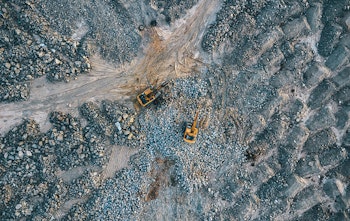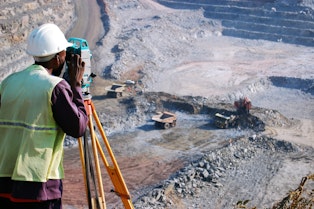
We know the future will be electric and a lot of it will depend on batteries. This is great news, because the means to create green electricity, via wind and solar, and to store it, via batteries, all depend on tried-and-tested technologies.
Wind energy has been used since the dawn of civilisation, solar has been around for almost two centuries and the lithium-ion battery was patented almost 50 years ago.
With these technologies we could probably electrify around 90% of the energy system, without the need for further breakthroughs.
Plus, wind and solar are among the cheapest forms of generation on the planet, and the despite a small increase last year lithium-ion batteries have been on a downward cost trajectory for the last decade. So, what is stopping us from implementing these technologies at massive scale?
One concern that sometimes gets levelled at the energy transition is that it will require unfeasibly large quantities of rare materials. It is undeniably true that decarbonising the energy system will put a strain on material supply chains, but is this really a showstopper? Some studies suggest so.
Perhaps the most pessimistic is by Simon Michaux of the Geological Survey of Finland.
In a widely cited yet not peer-reviewed technical report, Michaux worryingly concluded that the world’s mineral reserves in 2022 were insufficient to manufacture a single generation of renewable energy technologies, let alone power the planet in perpetuity.
Ignoring the elephant in the room—which is that the current energy system is itself completely unsustainable, with BP declaring peak oil had already been surpassed in 2020—there are reasons to suspect Michaux’s analysis may be flawed.

Indeed, more recent—and peer-reviewed—research has concluded that “geological reserves should suffice to meet anticipated needs,” and that the climate impact of extracting and processing them could be minimal.
That said, it still makes sense to strive for greater efficiency in material supplies for the energy transition, for at least five reasons.
Short-term supply shortages will delay the transition
Even though there may be more than enough precious materials to fuel the energy transition, that does not mean they are available immediately at reasonable prices.
On the contrary, a mismatch between the demand and the availability of battery materials has already caused an uptick in battery prices in recent months. Higher prices make projects less viable, slowing the energy transition at a time when it needs to be speeding up.
Making sure old batteries are recycled, and their materials used in new ones, could provide an important buffer in making sure such mismatches do not recur.
Current supply chains are at risk from geopolitical tensions
For better or worse, the energy transition is made in China. The country controls 85% of solar cell manufacturing and 87% of the processing capacity for rare earth materials used in wind turbines. It also owned 77% of lithium-ion battery manufacturing in 2022.
This dominance may not be a problem for companies such as Pacific Green, with deep and solid ties into the Chinese supply chain, but is a concern for policymakers because of its geopolitical risk.
Trade wars between China and western nations such as the US are not uncommon, and America’s solar industry has already had to deal with federal sanctions on imports, slowing the pace of the energy transition.
Moving to a circular industry model where more material is recycled could ultimately help all nations avoid such outcomes.
Circular economy approaches are more socially equitable
Today, many of the materials used in clean technologies are mined and processed in countries where oversight is limited and the potential for environmental and human rights abuses is thus greater. Cobalt, which is used in some lithium-ion batteries, is a frequently cited example.
More than 70% of the world’s cobalt is mined in the Democratic Republic of Congo. There, up to 30% of supply comes from artisanal mining with little control over workplace safety or labour rights.
The battery industry is aware of this problem, and at Pacific Green we use a battery chemistry called lithium iron phosphate that does not require any cobalt at all. Elsewhere, though, higher rates of recycling would undoubtedly reduce the potential for social inequity as the battery industry scales.
Investors want to get involved
Circular economy concepts such as recycling are a cornerstone of good environmental, social and governance (ESG) stewardship, and investors increasingly value companies that incorporate ESG into their business models.
In 2022, for example 76% of US and European fund managers added ESG criteria into their fixed-income investments, up from 42% in 2021.
It just makes good environmental sense
There is no doubt that society is using more of the Earth’s resources than it should, with the now-famous World Overshoot Day happening on August 2 in 2023. That means we use almost two Earth’s worth of resources per year, a clearly unsustainable level.
As developers supporting the energy transition, our priority at Pacific Green is to get low-carbon electrons onto the system as quickly and efficiently as possible.
But we are also mindful of the impact of our operations and support cleantech manufacturing industry efforts to improve recycling rates and embrace circular economy processes. Building a circular economy is not easy but there are plenty of examples of how it can be done.
China, as in so many other aspects of the energy transition, leads the way in lithium-ion battery recycling. The country recycled 188,000 tons of lithium-ion batteries in 2021, more than all the recycling that happened in Europe, North America and Oceania combined.
But other countries are looking to catch up, with Germany and the US each recycling more than 50,000 tons of lithium-ion batteries in 2021.
And remember it is still early days for large-scale lithium-ion recycling since most of the battery capacity available today is still hard at work in vehicles and energy storage plants. In time, it is to be hoped that lithium-ion recycling rates could approach those for lead-acid batteries.
These are the most widely recycled consumer product in the US, with a 99% recycling rate. If the lithium-ion industry can get near this level then it won’t just be known for storing energy, but also for saving materials.
Publish date: 20 March, 2024